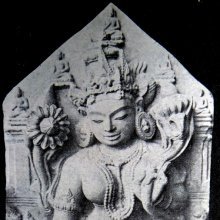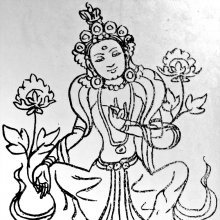Khadiravanitara, Khadiravaṇītārā, Khadiravani-tara: 2 definitions
Introduction:
Khadiravanitara means something in Buddhism, Pali, Hinduism, Sanskrit. If you want to know the exact meaning, history, etymology or English translation of this term then check out the descriptions on this page. Add your comment or reference to a book if you want to contribute to this summary article.
Images (photo gallery)
(+4 more images available)
In Buddhism
Tibetan Buddhism (Vajrayana or tantric Buddhism)
Source: archive.org: The Indian Buddhist IconographyKhadiravaṇītārā (खदिरवणीतारा) or simply Khadiravaṇī refers to one of the various emanations of Amoghasiddhi, as mentioned in the 5th-century Sādhanamālā (a collection of sādhana texts that contain detailed instructions for rituals).—Her Colour is green; her Mudrā is the varada; her Symbol is the utpala; her Companions are Aśokakāntā and Ekajaṭā.—Khadiravaṇī is endowed with two hands, showing the varada-mudrā in the right and the utpala in the left. She can be recognized by the figures of the two attendant deities, Aśokakāntāmārīcī and Ekajaṭā.

Tibetan Buddhism includes schools such as Nyingma, Kadampa, Kagyu and Gelug. Their primary canon of literature is divided in two broad categories: The Kangyur, which consists of Buddha’s words, and the Tengyur, which includes commentaries from various sources. Esotericism and tantra techniques (vajrayāna) are collected indepently.
Languages of India and abroad
Sanskrit dictionary
Source: Cologne Digital Sanskrit Dictionaries: Edgerton Buddhist Hybrid Sanskrit DictionaryKhadiravaṇītārā (खदिरवणीतारा).—name of a form of Tārā: Sādhanamālā 176.8.
Sanskrit, also spelled संस्कृतम् (saṃskṛtam), is an ancient language of India commonly seen as the grandmother of the Indo-European language family (even English!). Closely allied with Prakrit and Pali, Sanskrit is more exhaustive in both grammar and terms and has the most extensive collection of literature in the world, greatly surpassing its sister-languages Greek and Latin.
See also (Relevant definitions)
Partial matches: Khadiravani, Tara.
Full-text: Vashyatara, Khadiravani.
Relevant text
Search found 2 books and stories containing Khadiravanitara, Khadiravaṇītārā, Khadiravani-tara, Khadiravaṇī-tārā; (plurals include: Khadiravanitaras, Khadiravaṇītārās, taras, tārās). You can also click to the full overview containing English textual excerpts. Below are direct links for the most relevant articles:
Related products





